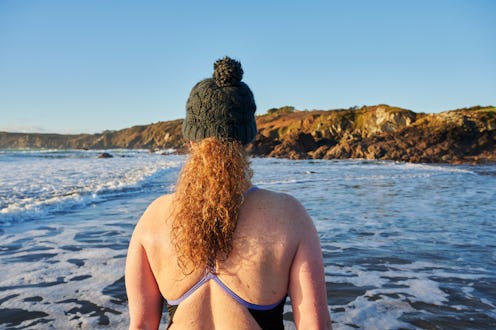Wellness
Take The Plunge, Try Wild Swimming
No pool membership? No prob.

People have been swimming in bodies of water since the dawn of time. Whether it’s a lake, ocean, or river, it’s human nature to want to take a dip. But be honest — when was the last time you actually went swimming? If you were into wild swimming, aka one of the biggest wellness trends mentioned at New York City’s 2023 Global Wellness Summit in January, you’d probably be in the middle of a lake right now.
Wild swimming is just what it sounds like: swimming outside in the wild. “It takes place in natural bodies of water such as rivers, lakes, and oceans, rather than in a swimming pool,” says Lalitha McSorley, PT, the lead physical therapist and owner of Brentwood Physiotherapy Calgary. The idea is to suit up — either in a bathing suit or wetsuit — and jump in for a freestyle swim or casual doggy paddle. “The distance you swim can vary depending on your experience and the conditions of the water,” McSorley tells Bustle. “Some wild swimmers prefer to swim in groups for safety, while others prefer to swim alone.”
With over 108 million views on TikTok, and countless videos of folks swimming in beautiful water, it really does make you want to skip the gym and find a swimmable lake instead. “One reason wild swimming is so popular is that it provides an opportunity to disconnect from technology and connect with nature, which can be a way to manage stress and improve mental health,” McSorley says. “Additionally, wild swimming is a low-impact and low-cost activity that’s accessible to people of all ages and abilities.” In other words, no pool membership? No prob.
The Benefits Of Wild Swimming
Since you can’t take your phone into a lake, this hobby is a good way to disconnect and spend some time with your thoughts while soaking (literally) in nature. “[Outdoor] exercise can help foster a more positive mindset, reduce anxiety, and have a significant impact on your mood,” says Holly Schiff, Psy.D., a licensed clinical psychologist with Jewish Family Services of Greenwich. “You can seek inspiration and peace as you commune with nature.”
Wild swimming is also a fun challenge. Once you get back to land and grab a towel, Schiff says you’ll feel a buzzy sense of empowerment and achievement that comes from trying something new, especially if you weren’t so sure about dipping your toes into a body of water. Of course, there are all sorts of physical benefits that come with wild swimming, too.
According to Michael Hamlin, NSCA, CSCS, a certified personal trainer and founder of Everflex Fitness, wild swimming improves your cardiovascular fitness, increases your strength and endurance, and improves circulation. “Swimming in cold water can also have a positive impact on the immune system, helping to reduce inflammation and enhance overall health,” he tells Bustle.
Since it’s recommended to swim in a group for safety reasons, McSorley notes there’s often a community aspect to wild swimming. Whether you drag a group of friends to a lake, join a local swim club, or challenge your partner to take a dip in a river, she says you’ll come ashore with a deeper sense of connection for having done something unique with friends — as well as a desire to go out for coffee ASAP.
How To Try Wild Swimming
Whether you slowly swim across a lagoon or do laps along the shoreline in the ocean, the point of wild swimming is to experience the beauty of nature, McSorley says. Of course, this is easier said than done if you live somewhere chilly. It’s always going to be more appealing to swim at the base of a tropical waterfall versus a murky, slimy lake. But you really can try wild swimming anywhere.
Heck, some people even go cold water swimming on purpose, like the famous “Ice Man” Wim Hof, who takes freezing dips as a form of mindfulness. That takes a lot of practice, however, and isn’t suggested for beginners.
“Before you try wild swimming, it’s important to ensure that you have the necessary skills and experience to swim safely in open water,” says Hamlin, whether it’s cold, warm, or otherwise. “Always swim with a buddy, check the weather and water conditions, and wear appropriate equipment, such as a wetsuit or swim cap.” You don’t want to get too cold, and you also don’t want to get in the way of boats, underwater debris, or other dangers, so remember to stay alert.
Beginners should start by swimming short distances, like a quick dip in a calm river or a short stroke across a quarry, before building up to longer laps in a wavy ocean or wide lake. “Always listen to your body and respect your limits,” Hamlin adds. “It's important to be mindful of the environment and respect local regulations and wildlife, too. Since there is no lifeguard in these places, be prepared for anything!” You want to go wild... just not too wild.
Studies referenced:
Knechtle, B. (2020). Cold Water Swimming-Benefits and Risks: A Narrative Review. Int J Environ Res Public Health. doi: 10.3390/ijerph17238984.
Lee, BA. (2015). Effect of regular swimming exercise on the physical composition, strength, and blood lipid of middle-aged women. J Exerc Rehabil. doi: 10.12965/jer.150242.
Massey, H. (2022). Perceived Impact of Outdoor Swimming on Health: Web-Based Survey. Interact J Med Res. doi: 10.2196/25589.
Safari, MA. (2020). The Effect of Swimming on Anxiety-Like Behaviors and Corticosterone in Stressed and Unstressed Rats. Int J Environ Res Public Health. doi: 10.3390/ijerph17186675.
van Tulleken, C. (2018). Open water swimming as a treatment for major depressive disorder. BMJ Case Rep. doi: 10.1136/bcr-2018-225007.
Sources:
Lalitha McSorley, PT, lead physical therapist, owner of Brentwood Physiotherapy Calgary
Holly Schiff, Psy.D., licensed clinical psychologist with Jewish Family Services of Greenwich
Michael Hamlin, NSCA, CSCS, certified personal trainer, founder of Everflex Fitness
This article was originally published on